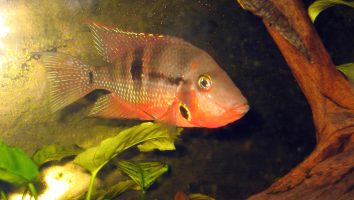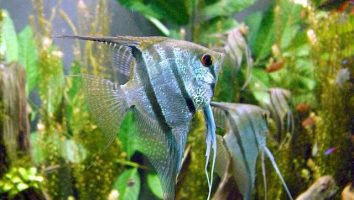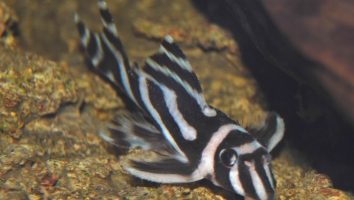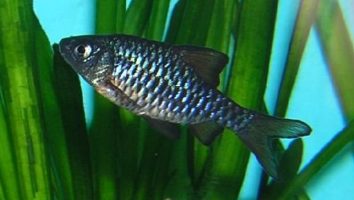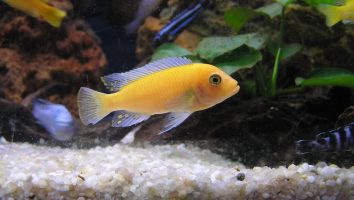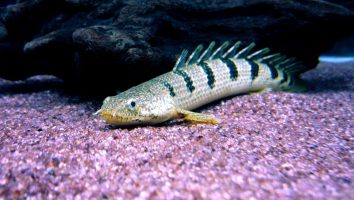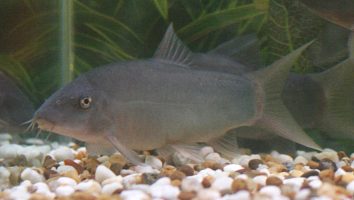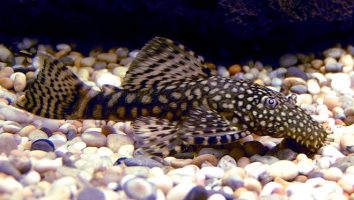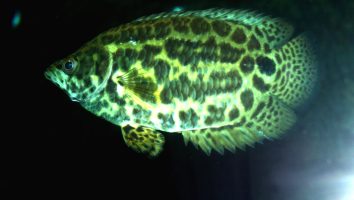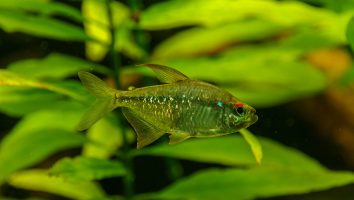The lyretail cichlid is a beautiful freshwater fish that is prized by many aquarists.
This fish is known for its stunning colors and patterns, and its long, flowing fins.
If you’re thinking about adding one of these fish to your tank, you’ll need to know how to care for them properly.
In this guide, we’ll teach you everything you need to know about lyretail cichlid care. You’ll learn about their diet, tank mates, lifespan, and more!
Table of contents
Species overview
Lyretail cichlids (scientific name: Herichthys cyanoguttatus) are freshwater fish that are native to Mexico and Central America. In the wild, they can be found in a variety of habitats including rivers, lakes, and streams.
They are a relatively large species of cichlid and can grow to be up to 12 inches (30 cm) in length. They are also known for their vibrant colors and patterns which can include everything from blues and greens to oranges and reds.
Lyretail cichlids are a popular choice for many aquarium enthusiasts due to their bright colors and peaceful nature. They are also relatively easy to care for, which makes them a good option for beginner fishkeepers.
Appearance

The Lyretail cichlid is a very beautiful fish that is easily recognizable thanks to its unique fins.
The body shape of this fish is long and torpedo-like with a slightly rounded belly. They have a fair amount of coloration that can range from blues, greens, and even oranges.
The fins on a Lyretail cichlid are very prominent and make up a large portion of their overall appearance.
The dorsal fin is very tall and begins about two-thirds of the way back on the body. It curves slightly as it extends back and ends in a point.
The anal fin is similar in both size and shape to the dorsal fin. It also starts two-thirds of the way back and curves back before ending in a point.
The caudal fin is forked and extends back quite far. The tips of the caudal fins are often a different color than the rest of the fish.
The pectoral fins are long and thin. They begin right behind the gill plate and extend back to about the middle of the fish.
The ventral fins are also long and thin. They start a little bit behind the pectoral fins and extend back to the anal fin.
Lyretail cichlids also have a long filament that extends from the back of the dorsal fin. This filament is often the same color as the tips of the caudal fins.
Lifespan
The average lifespan of a Lyretail cichlid is around 10 years. There are a number of factors that impact their life expectancy.
For starters. if these fish haven’t reproduced then their lifespan will usually be on the higher side of this range. That process can really take a toll on the fish.
The general level of care they receive obviously matters a great deal as well. Even though these are very hardy fish, they’ll obviously live longer in optimal conditions.
Size
Lyretail cichlids can grow to be quite large, with some specimens reaching up to 16 inches in length. However, the average size for these fish is around 12 inches.
As you can see, these fish can get quite large, so you’ll need to make sure you have a tank that can accommodate them. They also need to be kept with other fish that are of a similar size, as they can become aggressive if they feel like they are being overcrowded.
Tank
Tank Size
The minimum tank size for a Lyretail cichlid is 50 gallons. If you’re looking for a freshwater fish that can fit in an average-sized tank, this is not the fish for you.
If you want to keep two Lyretail cichlids in the same tank you’ll want to add at least another 50 gallons to that minimum number if you want them to thrive.
Another reason why you need to provide enough space is for the sake of enrichment and comfort. These fish like to roam and will often run gentle but steady laps around your tank. Giving them a little bit of extra space can go a long way in making sure they can comfortably turn around in the tank.
Water Parameters
The lyretail cichlid is a freshwater fish that is native to the waters of Central and South America. In the wild, they can be found in rivers, lakes, and streams.
The lyretail cichlid is a tropical fish and requires warm water to thrive. The ideal water temperature for this species is between 78 and 82 degrees Fahrenheit.
The pH level of the water should be between 6.5 and 7.5. The water hardness should be between 4 and 8 dGH.
The lyretail cichlid is a peaceful fish but can be aggressive towards other fish that are similar in size and appearance. They should be kept with other peaceful cichlids or fish that are too large to be considered prey.
- Water Temperature: 78-82 degrees Fahrenheit
- pH Levels: 6.5-7.5
- Water Hardness: 4-8 dGH
- Alkalinity Levels: 6-8 dKH
What To Put In Their Tank
When setting up a Lyretail cichlid’s tank there are a few key things you need to remember. First and foremost among these is that these fish like to dig. A lot.
This means that you need to go with a substrate that won’t be easily displaced or kicked up. Sand is always a good choice, but you can also use something like small gravel.
The second thing you need to take into consideration is that these fish are jumpers. A lot of times when they’re feeling stressed they’ll try to jump out of the tank. This can obviously lead to some serious injuries (or worse).
To combat this you need to make sure there’s no easy way for them to escape. This means having a tight-fitting lid on the aquarium and making sure there aren’t any gaps.
Other than that, these fish don’t have any specific needs when it comes to decorations. You can go with live plants if you want, but be aware that they might uproot them. Driftwood and rocks are always a good choice.
Common Diseases
While lyretail cichlids are a fairly robust fish, they can still succumb to disease and poor water conditions. The most common illness that these fish experience is ich.
Ich is a very common parasitic infection that can affect both freshwater and saltwater fish. It’s caused by a single-celled organism that buries itself into the skin of the fish.
The most obvious symptom of ich is the presence of white spots on the body of the fish. These spots will sometimes appear on the gills and fins as well.
If left untreated, ich can be fatal. However, it’s relatively easy to treat if you catch it early. There are a variety of ich treatments available, so consult your vet or a fish care guide to find the best one for your situation.
As we mentioned, the best way to prevent ich (and other diseases) is to maintain clean and stable water conditions in your tank. A healthy environment will go a long way in keeping your fish happy and disease-free.
Behavior & Temperament
Lyretail cichlids are not for the faint of heart. These fish have major attitude problems. They’re territorial, aggressive, and known to be fin nippers.
The biggest problem with Lyretail cichlids is that they’re not picky about who they attack. They’ll go after fish that are much larger than them, as well as fish that are smaller.
It doesn’t matter if the fish is a peaceful community fish or a feisty cichlid like themselves, they’re all potential targets.
The good news is that Lyretail cichlids can be kept in a tank with other fish, as long as the tank is big enough and there are plenty of hiding spots. We recommend a tank that is at least 75 gallons for these fish.
Another thing to keep in mind is that Lyretail cichlids are known to be jumpers. They have been known to jump out of tanks that don’t have a lid. So, make sure your tank is covered!
Tank Mates
Lyretail cichlids are not the friendliest fish in the world. They’re actually quite aggressive and territorial.
This means that their tank mates need to be able to hold their own. Smaller, passive fish simply won’t do.
The good news is that there are plenty of large, aggressive fish that can stand up to a lyretail cichlid. These are some of the best tank mates for lyretail cichlids:
- Oscar Fish
- Jack Dempsey
- Green Terror
- Firemouth Cichlid
- Convict Cichlid
- Blood Parrot Cichlid
- Plecostomus (large species)
- Arowana
- Pacu
Breeding
Lyretail cichlids are beautiful fish that make great additions to any aquarium. They’re also relatively easy to breed in captivity.
The first step is to set up a suitable breeding tank. These fish need a lot of space, so the tank should be at least 75 gallons. It should also have plenty of hiding places and a sandy substrate.
Water quality is also important. The pH should be between 7.5 and 8.5, and the water should be fairly hard. A good way to achieve this is to use reverse osmosis water and then add some crushed coral to the tank.
When everything is ready, you can add a pair of fish to the tank. It’s best to add one male and one female, but you can also add two males if you’re having trouble finding a female.
Lyretail cichlids are mouthbrooders, which means that the female will incubate the eggs in her mouth. After the eggs are fertilized, the female will pick them up and keep them in her mouth for about three weeks.
During this time, the female will stop eating. The male will still need to be fed, so he may need to be removed from the tank.
Once the fry are ready to be released, the female will open her mouth and release them into the water. At this point, you can start feeding them baby brine shrimp or other small live foods.
Conclusion
The Lyretail cichlid is a beautiful fish that is perfect for the intermediate to advanced aquarium owner. They are not a difficult fish to care for, but they do require a little more attention than some of the other fish on this list.
If you are looking for a fish that is a little more challenging but still relatively easy to care for, the Lyretail cichlid is a great option. Just be sure to do your research and be prepared to provide them with the proper care and attention they need to thrive.

